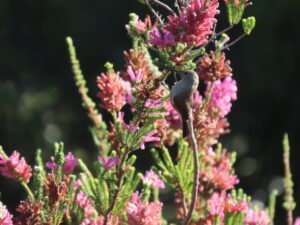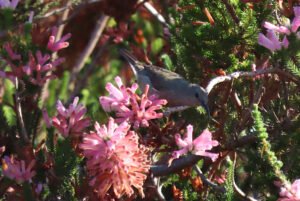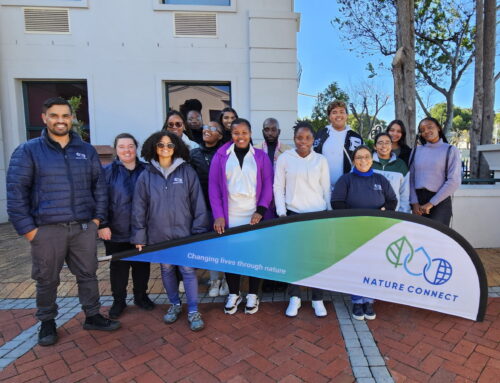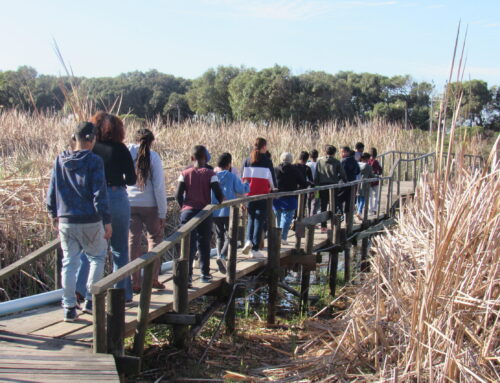Written by Llewellyn Williams
April 13th is International Plant Appreciation Day, a dedicated day to celebrate the incredible ways plants enrich our lives and the planet. From the oxygen we breathe to the vibrant landscapes we cherish, plants are the foundation of a healthy world. They not only provide food and resources for us but also create vital habitats for birds and other wildlife, ensuring a balanced and thriving ecosystem. One such ecosystem is the Kenilworth Racecourse Conservation Area (KRCA). Due to its location, it has been left undisturbed for more than 100 years, making it now the best-preserved patch of Cape Flats Sand Fynbos (CFSF) in the world. Nature Connect’s dedicated conservation team is responsible for the day to day management of KRCA, working to conserve the biodiversity of the 52-hectare site and restore its natural state.
During a monthly bird survey at the conservation area in early 2024, a remarkable conservation success story unfolded. The ‘extinct in the wild’ Erica verticillata (Whorled Heath), a model example of the Cape Flats Sand Fynbos’ unique flora was observed in full bloom. This special plant was first reintroduced to KRCA by the management team almost 10 years ago. This encounter wasn’t just a visual treat, the attractive flowers of E. verticillata have attracted Southern double-collared sunbirds in ever-increasing numbers since its re-introduction. This mutually beneficial plant-pollinator interaction plays an important role in the successful reproduction of this rare plant. The tubed flowers of E. verticillata are morphologically suited to the beak shape of the Southern double-collared sunbird.
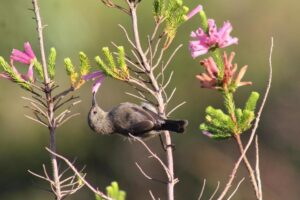
A Brush with Extinction: A Loss for the Cape Flats Sand Fynbos
E. verticillata isn’t the only resident of the Cape Flats Sand Fynbos that has faced extinction. This unique and critically endangered vegetation type, once the most common in Cape Town, has suffered tremendous damage due to human activity. These low-lying plains, carpeted with fynbos shrubs, were historically bypassed by early travellers due to the sandy conditions that bogged down wagons.
The Cape Flats Sand Fynbos thrives in deep, white, acidic sands and is considered the wettest and coldest subtype of West Coast Sand Fynbos. Dominated by Proteoid and Restioid fynbos, with Ericaceous fynbos present in wetter areas and Asteraceous fynbos in drier spots, this diverse ecosystem is a haven for a variety of plant and animal species. Seasonal wetlands dot the landscape in winter, and blankets of mist often shroud the area, creating an otherworldly atmosphere.
Unfortunately, by the mid-20th century, habitat loss due to agricultural development and urban sprawl had pushed the Cape Flats Sand Fynbos to the brink. This vegetation type was once widespread across the low-lying plains that surround Cape Town. This amounted to over 500 square kilometers of fynbos vegetation. However, only about 10% remains (M. Smith, et. al, 2020), and most of that is in fragmented patches and not in pristine condition. A mere 1% is formally conserved. E. verticillata is a prime example of this struggle. With its whorled arrangement of delicate flowers, this fynbos plant was once a common sight. By the mid-20th century, however, it had vanished from the wild, believed to be lost forever.
A Spark of Hope:
The story of E. verticillata’s rediscovery and reintroduction offers a beacon of hope for the future of the Cape Flats Sand Fynbos. In 1984, Dawid von Well, a Kirstenbosch scholar, discovered a single Erica verticillata growing at Jan Cilliers Park in Pretoria, far from its natural habitat. This remarkable find sparked renewed hope for the species. Cuttings were taken, and the plant was successfully reintroduced into botanical gardens around the world, including Kirstenbosch National Botanical Garden. These plants at Jan Cilliers Park were originally planted in the 1960s by curator J.E. Repton. (von Braun et al., 2023, p. 160).
Within a recent period, the hunt for more lost Ericas continued. With the help of botanical societies, gardeners, and even some internet investigations, specimens were tracked down from Vienna’s Belvedere Palace Garden. They had been quietly preserving Cape Ericas for over 200 years. It all started when two plant enthusiasts, Francis Boos and George Scholl, went on a plant-collecting adventure for Emperor Joseph II of Austria in the late 1700s. Despite wars and bombings, their collection survived, thanks to the clever relocation to a cosy earth house at the Alpengarten. In 1990, a specimen of E. verticillata was discovered at Kirstenbosch National Botanical Garden, thanks to the keen observation of the Head Foreman, Adonis Adonis. During one of his routine walks along the Braille Trail, Adonis stumbled upon a cluster of plants behind the trail. Upon closer inspection, he recognised their resemblance to E. verticillata (von Braun et al., 2023, p 159).
Kenilworth Racecourse: Cultivating Hope
Kenilworth Racecourse Conservation Area, recognising the importance of E. verticillata, actively participated in its reintroduction efforts. The on-site fynbos nursery plays a crucial role in this mission. Here, skilled staff cultivate a variety of endangered plant species, including E. verticillata. Using cuttings collected from existing healthy plants, the nursery meticulously propagates new specimens. This ensures a steady supply of plants for reintroduction efforts within the conservation area.
Reintroduction: A Learning Experience and A Success Story
In 2004, Kenilworth Racecourse embarked on their initial large-scale reintroduction effort for E. verticillata. Demonstrating a commitment to learning and improvement, conservation experts meticulously planned this endeavor. One hundred E. verticillata plants, comprising three distinct clones – 50 ‘African Phoenix’, 25 ‘Adonis’, and 25 ‘Louisa Bolus’ – were carefully transplanted within 100 meters of each other in a seasonally wet depression at KRCA. These young plants, cultivated in 1kg bags to promote healthy root development, were strategically placed within mature vegetation. This provided essential protection from the harsh summer heat and wind, a critical factor for their survival.
The results were impressive. Eighty percent of these reintroduced E. verticillata plants thrived! They have flowered profusely every year since, becoming a vibrant part of the restored fynbos ecosystem. This initial success story provided valuable insights that would guide future reintroduction efforts (von Braun et al., 2023, p. 165).
A Flourishing Future: Erica verticillata Awaits Potential Bloom After 2021 Prescribed Burn
In the first quarter of 2021, a prescribed burn was undertaken at the Kenilworth Racecourse Conservation Area This ecological management tool mimics natural veld fires and is a driver in the fynbos ecosystem (Yeld, 2021. Par 10). A new generation of E. verticillata awaits in the post-fire plant succession, thanks to the successful reintroduction efforts in 2004.
Looking Forward: Potential Impact on Erica verticillata
While we haven’t witnessed the outcome yet, experts believe the controlled burn could lead to a vibrant display of E. verticillata flowers in the coming years. These reintroduced plants, once ‘extinct in the wild,’ are showing promise at KRCA because of the ongoing conservation efforts.
Hope for Erica verticillata’s future
The KRCA team is hopeful that with continued work and the potential benefits of the prescribed burn, the E. verticillata population will flourish. The ultimate goal is to see it delisted from “extinct in the wild,” signifying a remarkable comeback story for Cape Town’s unique flora.
An improving Ecosystem Today
The E. verticillata you see at Kenilworth Racecourse today is a testament to the ongoing success of these reintroduction efforts. The knowledge gained from the early challenges proved invaluable, and the current increasing population is a beacon of hope for the future of this once-extinct plant. Organisations like the South African National Biodiversity Institute (SANBI), the City of Cape Town (CCT), and Nature Connect all played a part in the reintroduction efforts.
Continued reintroduction efforts are still underway in different sections of the conservation area. The last reintroduction was undertaken in 2017 together with these organisations. Following the same process of the first reintroduction, these ones were also planted in seasonally damp depressions and are already reaching heights of approximately 1.2 meters, while showing off their clusters of deep pink, tubed flowers.
A Symbiotic Success Story:
The return of E. verticillata to Kenilworth has not only enriched the fynbos ecosystem but also attracted its vital pollinator, the Southern double-collared sunbird. These sunbirds, with their iridescent plumage and long, curved bills, are perfectly adapted for feeding on the nectar of the Erica’s flowers. As they flit from flower to flower, sipping nectar, they inadvertently transport pollen on their feathers, ensuring the continued reproduction of the Erica. This mutually beneficial relationship exemplifies the interconnected web of life within the fynbos.
Witnessing the Comeback:
Come witness this remarkable comeback firsthand! Visit Kenilworth Racecourse Conservation Area and see E. verticillata in bloom, attracting a flurry of Southern double-collared sunbird activity. Explore the diverse fynbos landscape and learn about the ongoing conservation efforts that are bringing this unique ecosystem back from the brink.
Want to learn more?
- Join a guided night walk: Kenilworth Racecourse offers guided night walks, where you can discover the fascinating nocturnal inhabitants of the fynbos, such as owls, porcupines, and genets.
- Visit the Kenilworth Racecourse Instagram and Facebook page : Learn more about the conservation efforts at Kenilworth Racecourse and how you can get involved in protecting this vital ecosystem.
The story of E. verticillata and the Southern double-collared sunbird is a testament to the power of conservation. Through dedicated efforts, we can restore balance to our ecosystems and ensure a future where these beautiful species can thrive once again.
Curios to find out more? Read Erica verticillata, from Extinction to Restoration by Anthony Hitchcock: Chapter 46 of Science and Actions for Species Protection: Noah’s Arks for the 21st Century, the proceedings of the Pontifical Academy of Sciences’ Proceedings of the Workshop of 13-14 May 2019, edited by Jurgen von Braun, Thomas Kauffels, Peter Raven, Johannes Vogel and Marchello Sánchez Sorondo and published by Libreria Editrice Vaticana.
Photos
Fayruz Prins: https://www.inaturalist.org/observations/155710798
Dinofelis : https://www.inaturalist.org/observations/108114738
Callumevans: https://www.inaturalist.org/observations/11197745


